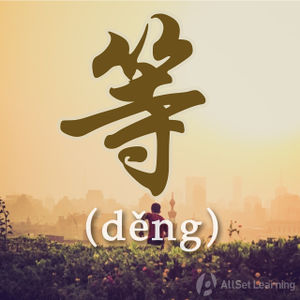Difference between revisions of "Non-exhaustive lists with "dengdeng""
| Line 3: | Line 3: | ||
等等 (děng děng), or simply 等 (děng), is just like saying “and so on” or “etc.” in English, but just a bit more formal. Both are placed after listing a series of items (generally with a list that exceeds two items). | 等等 (děng děng), or simply 等 (děng), is just like saying “and so on” or “etc.” in English, but just a bit more formal. Both are placed after listing a series of items (generally with a list that exceeds two items). | ||
| − | == | + | == Structure == |
The basic structure is easy. Just make a list of things, and add 等 (děng) or 等等 (děng děng) to the end of the list. It's the same as in English when we use "etc." at the end of a list. | The basic structure is easy. Just make a list of things, and add 等 (děng) or 等等 (děng děng) to the end of the list. It's the same as in English when we use "etc." at the end of a list. | ||
| − | |||
| − | |||
<div class="jiegou"> | <div class="jiegou"> | ||
| − | + | A1,A2 ⋯⋯ 等 / 等等 | |
</div> | </div> | ||
| − | + | == Examples == | |
<div class="liju"> | <div class="liju"> | ||
| Line 25: | Line 23: | ||
</div> | </div> | ||
| − | + | 等 (děng) can also be added to the end of a list and is followed by a noun that represents the list. In this case, you can only use 等: | |
| − | |||
| − | |||
| − | |||
| − | |||
<div class="jiegou"> | <div class="jiegou"> | ||
| − | + | A1,A2 ⋯⋯ 等 + [Category] + Predicate | |
</div> | </div> | ||
| − | |||
The [[predicate]] part of the pattern can be a verb or an adjective. | The [[predicate]] part of the pattern can be a verb or an adjective. | ||
| − | |||
| − | |||
<div class="liju"> | <div class="liju"> | ||
| Line 61: | Line 52: | ||
[[Category:B1 grammar points]] | [[Category:B1 grammar points]] | ||
| − | {{Basic Grammar|等|B1| | + | {{Basic Grammar|等|B1|A1,A2 ⋯⋯ 等 / 等等|长城、故宫 <em>等</em> 地方 都 是 北京 有名 的 景点 。 |grammar point|ASGF763H}} |
{{Rel char|等等}} | {{Rel char|等等}} | ||
{{Similar|Ending a Non-Exhaustive List with "shenme de"}} | {{Similar|Ending a Non-Exhaustive List with "shenme de"}} | ||
Revision as of 02:58, 19 December 2017
-
Level
-
Similar to
-
Used for
-
Keywords
等等 (děng děng), or simply 等 (děng), is just like saying “and so on” or “etc.” in English, but just a bit more formal. Both are placed after listing a series of items (generally with a list that exceeds two items).
Structure
The basic structure is easy. Just make a list of things, and add 等 (děng) or 等等 (děng děng) to the end of the list. It's the same as in English when we use "etc." at the end of a list.
A1,A2 ⋯⋯ 等 / 等等
Examples
- 西瓜、菠萝、苹果、葡萄 等等 都 是 我 喜欢 的 水果 。 Watermelons, pineapples, apples, grapes and so on are all the fruits that I like.
- 我 的 男朋友 会 说 很 多 外语 , 英语、法语、西班牙语 等等 。 My boyfriend can speak many foreign languages: English, French, Spanish, etc.
- 我 很 喜欢 运动,比如 跑步、游泳、做瑜伽 等等 。I like exercising very much, for example, running, swimming, doing yoga, etc.
- 我们 公司 有 好几 个 部门,市场部、客户部、技术部 等 。Our company has several departments: marketing department, client department, technology department, etc.
- Jackie Chan、Jet Li、Bruce Li 等 都 是 中国 有名 的 功夫 明星 。 Jackie Chan, Jet Li, Bruce Li, etc. are all famous Chinese martial arts stars.
等 (děng) can also be added to the end of a list and is followed by a noun that represents the list. In this case, you can only use 等:
A1,A2 ⋯⋯ 等 + [Category] + Predicate
The predicate part of the pattern can be a verb or an adjective.
- 长城、故宫 等 地方 都 是 北京 有名 的 景点 。 The Great Wall, the Forbidden City, etc. are all famous scenic spots in Beijing.
- 北京、上海、广州 等 城市 的 经济 都 很 发达 。Beijing, Shanghai, Guangzhou and so on are economically developed cities.
- 牛津、剑桥 等 大学 是 英国 最 有名 的大学 。Oxford, Cambridge and so on are the most famous British Universities.
- 中国、印度、巴西 等 国家 都 是 发展中 国家 。China, India, Brazil and so on are all developing countries.
- 食品安全、环保、和平等 话题 都是 热点 话题 。Food safety, environmental protection, peace and so on are all hot topics.



